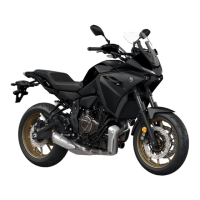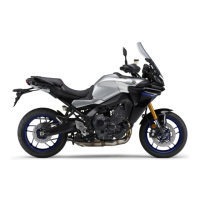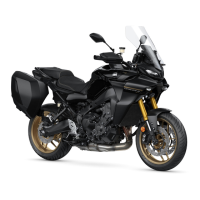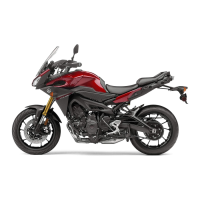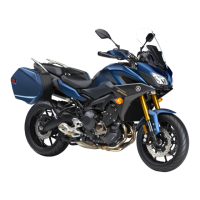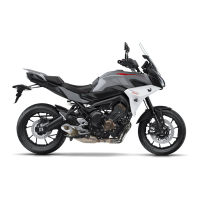Do you have a question about the Yamaha TRACER and is the answer not in the manual?
Overview of the manual's purpose, model features, and general advice.
Explains the meaning of WARNING, NOTICE, and TIP notations used in the manual.
Emphasizes owner responsibility for safe motorcycle operation and maintenance.
Provides guidance on safe riding techniques, visibility, and hazard avoidance.
Details essential protective gear for rider safety and injury prevention.
Warns about carbon monoxide hazards and proper motorcycle loading.
Advises caution regarding aftermarket parts and potential safety risks.
Illustrates and labels key components visible from the left side of the vehicle.
Illustrates and labels key components visible from the right side of the vehicle.
Identifies and locates various controls and instrument panel features.
Explains the functions of the main switch and how to operate the steering lock.
Details the function of each switch located on the left and right handlebars.
Describes the various indicator and warning lights on the instrument panel.
Explains how to activate, adjust, and deactivate the cruise control system.
Explains the instrument display items and how to navigate the menu system.
Details the D-mode selections and operation of the clutch lever.
Explains the operation of the shift pedal and the quick shift system.
Describes the operation of the brake pedal and lever, including ABS function.
Explains the function, settings, and reset procedure for the traction control system.
Provides instructions on how to adjust the rider seat to different heights.
Guides on adjusting front fork spring preload and damping, and rear shock absorber.
Explains the safety system that prevents starting under certain conditions.
Lists essential checks for fuel, engine oil, coolant, and front brake.
Outlines checks for rear brake, clutch, throttle grip, cables, drive chain, and tires.
Covers checks for chassis fasteners, instruments, lights, switches, and sidestand.
Details the correct procedure for starting the engine and pre-ride checks.
Explains gear shifting, recommended shift points, and quick shift system.
Provides guidance for the initial engine break-in period to ensure longevity.
Outlines safe procedures and warnings for parking the vehicle.
Lists the tools provided and their intended use for maintenance.
Details periodic maintenance intervals for emission control and general service.
Covers checking spark plugs and servicing the engine oil and filter.
Guides on tire checks, air pressure, brake pad wear, and fluid levels.
Explains how to adjust, clean, and lubricate the drive chain and control cables.
Details checks for front fork condition, steering bearings, and wheel bearings.
Covers battery type, checks, charging, and storage procedures.
Explains the location of fuse boxes and the procedure for replacing fuses.
Provides instructions for replacing headlight, auxiliary, and signal light bulbs.
Provides charts and guidance for diagnosing and resolving starting or performance problems.
Offers steps to diagnose and address engine overheating issues.
Details safe methods for cleaning the motorcycle, including special precautions.
Provides instructions for short-term and long-term storage to protect the motorcycle.
Lists key physical dimensions, weight, and engine configuration.
Details engine type, displacement, oil, fuel, and drivetrain ratios.
Provides technical details on the braking system and suspension components.
Details battery type, bulb wattages, and fuse ratings.
Guides on recording VIN, engine serial, and key identification numbers.
Outlines the terms and conditions of the limited warranty and exclusions.
Explains the benefits and flexibility of the Y.E.S. extended service plan.
Overview of the manual's purpose, model features, and general advice.
Explains the meaning of WARNING, NOTICE, and TIP notations used in the manual.
Emphasizes owner responsibility for safe motorcycle operation and maintenance.
Provides guidance on safe riding techniques, visibility, and hazard avoidance.
Details essential protective gear for rider safety and injury prevention.
Warns about carbon monoxide hazards and proper motorcycle loading.
Advises caution regarding aftermarket parts and potential safety risks.
Illustrates and labels key components visible from the left side of the vehicle.
Illustrates and labels key components visible from the right side of the vehicle.
Identifies and locates various controls and instrument panel features.
Explains the functions of the main switch and how to operate the steering lock.
Details the function of each switch located on the left and right handlebars.
Describes the various indicator and warning lights on the instrument panel.
Explains how to activate, adjust, and deactivate the cruise control system.
Explains the instrument display items and how to navigate the menu system.
Details the D-mode selections and operation of the clutch lever.
Explains the operation of the shift pedal and the quick shift system.
Describes the operation of the brake pedal and lever, including ABS function.
Explains the function, settings, and reset procedure for the traction control system.
Provides instructions on how to adjust the rider seat to different heights.
Guides on adjusting front fork spring preload and damping, and rear shock absorber.
Explains the safety system that prevents starting under certain conditions.
Lists essential checks for fuel, engine oil, coolant, and front brake.
Outlines checks for rear brake, clutch, throttle grip, cables, drive chain, and tires.
Covers checks for chassis fasteners, instruments, lights, switches, and sidestand.
Details the correct procedure for starting the engine and pre-ride checks.
Explains gear shifting, recommended shift points, and quick shift system.
Provides guidance for the initial engine break-in period to ensure longevity.
Outlines safe procedures and warnings for parking the vehicle.
Lists the tools provided and their intended use for maintenance.
Details periodic maintenance intervals for emission control and general service.
Covers checking spark plugs and servicing the engine oil and filter.
Guides on tire checks, air pressure, brake pad wear, and fluid levels.
Explains how to adjust, clean, and lubricate the drive chain and control cables.
Details checks for front fork condition, steering bearings, and wheel bearings.
Covers battery type, checks, charging, and storage procedures.
Explains the location of fuse boxes and the procedure for replacing fuses.
Provides instructions for replacing headlight, auxiliary, and signal light bulbs.
Provides charts and guidance for diagnosing and resolving starting or performance problems.
Offers steps to diagnose and address engine overheating issues.
Details safe methods for cleaning the motorcycle, including special precautions.
Provides instructions for short-term and long-term storage to protect the motorcycle.
Lists key physical dimensions, weight, and engine configuration.
Details engine type, displacement, oil, fuel, and drivetrain ratios.
Provides technical details on the braking system and suspension components.
Details battery type, bulb wattages, and fuse ratings.
Guides on recording VIN, engine serial, and key identification numbers.
Outlines the terms and conditions of the limited warranty and exclusions.
Explains the benefits and flexibility of the Y.E.S. extended service plan.
| Compression Ratio | 11.5 : 1 |
|---|---|
| Fuel System | Fuel Injection |
| Transmission | 6-speed |
| Front Suspension | Telescopic fork |
| Starter System | Electric |
| Final Drive | Chain |
| Rear Suspension | Swingarm |
| Front Brake | Hydraulic dual disc |
| Rear Brake | Hydraulic disc |
| Front Tire | 120/70ZR17 |
| Rear Tire | 180/55ZR17 |
| Engine Type | Liquid-cooled, 4-stroke, DOHC, 4-valve |
